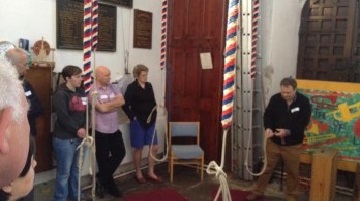M1: 18th Apr 2015 - Over
A personal perspective by an bell handling training participant
The Association of Ringing Teacher (ART) have been promoting the ITTS training courses by various means for the past few years. I have read some of their, seemingly, all-pervading communications about becoming a Ringing Teacher and, increasingly, took more interest. When the opportunity to attend Over Church materialised the reality of our local ringing world seemed to hold me back. To fully participate and fully complete this ART training it seemed you needed to;
- Ring up and down in rounds: This is the recommended ‘entry qualifications’ for a Ringing Teacher for M1.
- Have a Mentor: This is not as easy as it sounds. Ideally you need somebody who can ring better than you that you get on with, that can spare the time, that is interested and that is relatively local implying you ring together.
- Have a computer: This was for something called “Moodle” (No, I’d never heard of it either!) – More on this later.
- Have somebody to teach to ring from scratch: I’d suggest that this is going to be the stumbling block for many of us.
There are currently two courses in the ITTS Ringing Teacher training programme. Module 1 (M1) and Module 2 (M2).
- M1 – For aspiring Ringing Teachers to instruct in basic bell handling (this was the course held at Over’s Tower).
- M2 – For aspiring Ringing Teachers to instruct in basic method ringing (just beyond Plain Hunt to Bob Doubles).
Completing all of any one module (not just the day course) means you can become an ART Ringing Teacher (become an Associate Member of ART). Completing all of both modules (not just the day courses) means you can become a Full Member.
When I had finally convinced Jeanette (who is also my wife, as it happens!) to act as my Mentor (Jeanette fulfilled the requirements above!) we applied on-line for the training and after the usual web-page sign-up we were eventually registered to attend (the last two places). There were 18 attendees (presumably half aspiring Ringing Teachers and their Mentors). Lesley Boyle acted as the Over Church tower’s ‘camp host’ ably arranging tea, cakes, soup sandwiches and support. The two M1 course tutors were Roger Booth and Gill Hughes. Jeanette and I had previously rung with Gill and we all actually remembered where and when. The course was structured to be about 15% theory (classroom like) with 85% practical (ringing). This theory/practical mix worked very well.
The classroom sessions covered;
- Why ITTS was set up: Statistics concerning the ringing population and competing comparable activities.
- Module Structure: Module 2 (M2) may be split to become two separate events (this made sense to me).
- 2a being the Ringing Teacher training for…. “From Rounds through Call Changes to Plain Hunt”.
- 2b being the Ringing Teacher training for…. “From Plain Hunt to Bob Doubles”.
- The On-line Work: This was a program called “Moodle” which offers the on-line assessment for the day courses and other relevant training material. “Moodle” is obsolete and the new on-line work is using the program “Smart Ringer”.
- Learning the Ropes: This is like a graded curriculum for bell ringers. When each ringing learner passes each one of the 5 levels of increasing difficulty then certificates are available. Fuller information is available here .
- Learning Techniques: Covering new ideas & old ideas. It covered how people learn (verbal, demonstrations, prompting and physical assistance). I particularly liked the concept of moving learning from short term memory “How do I ring” towards longer term memory “I don’t need to think about the ringing itself anymore so now I can think about how to do this method”.
- Practical Learning: The approach of learning to ring at practices by a few minutes here and there during gaps in other’s ringing is not the proffered method by ITTS. Ringers should learn to ring in relative obscurity but for longer more intensive periods. This means that they don’t feel like they are taking up other ringers’ practice as well as not looking embarrassed when things don’t go quite right (that’s more embarrassing for adults than youngsters). Using a mix of existing and new tools along with an appreciation of learning theory means that a newcomer should be ringing in about 30 hours over a few weeks not over months. It was stressed that all beginners may learn in different ways, times and sometimes instructors.
The Practical Rope Time included the right safety messages for new ringers. We learned instructional techniques for ringing backstroke, then hand stroke and then joining the two strokes together. The course covered instructional techniques for ringing up and then ringing down. The final practical session concerned the identification then possible rectification techniques for bell handling issues. This last topic was particularly interesting for me as people watched my wandering right hand – But I’m working on that! My favourite practical parts of the course were; “How to pass the tail to another ringer while the bell is being rung” then the scary “Drop your rope while ringing then pick it up” – not everybody wanted to do that (but I did!)
My take away message for the course was that it was, indeed, worth doing. Being in the same room as others with the same goals was quite inspiring. We may well move to accreditation (Teacher for me and Mentor for Jeanette) but that’s yet to come.
Bob Cox, Walsoken

Course Tutor
Gill Hughes
Teaching Bell Handling
Practical advice for teachers, right from the first lesson.